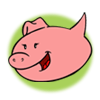
Uncovering America's Heritage... Coin by Coin
Hogge Money
Wowee! It's my favorite coin: a coin with a pig on it! I feel like a celebrity!
Even though this coin isn't American (it's from Bermuda), the United States did have a military base on Bermuda for a long time. And Americans enjoy Bermuda onions, Bermuda grass, and Bermuda shorts!
Plus the closest land to Bermuda is the United States...Cape Hatteras, North Carolina, to be exact. Even so, it's pretty far away: almost 570 miles of nothing but water.
Inspector Collector says that 570 miles is:
- The distance between San Francisco, in Northern California, and Los Angeles, in Southern California.
- The length of the American Discovery Trail, which crosses Kansas near the old Santa Fe Trail.
- The distance above the earth that the LandSat satellites orbit and gather data about the earth.
But let's get back to that handsome pig! It seems that he got to the Bermuda islands by boat. Juan de Bermudez was shipwrecked there by a hurricane in 1532, and he probably had a cargo of black hogs that swam ashore. Nobody wanted to live on the island because they thought it was full of demons, so the pigs went "hog wild" for years!
Well, in 1609, the Virginia Company sent the Sea Venture and other ships from England with supplies and new settlers for the two-year-old Jamestown settlement. But another storm sent the Sea Venture to Bermuda instead of Virginia. The ship was wrecked there in July, and that began the settling of the islands of Bermuda—six main islands and lots of teenie weenie ones.
The commander of the fleet, General Sir George Somers, claimed the islands for England, set up a colony on one of them, and renamed them "Sommers Isles," which is still another name for Bermuda. The herds of wild hogs made many a happy meal for the settlers there and in Jamestown.
Then England decided to support the new colony by letting it mint its own coins. Bermuda's governor had the coins made in England and then shipped to Bermuda. That makes them the first colonial coins in the English-speaking part of the New World. What better symbol could be put on the coins than a wild hog? ...And a cute hog at that!




